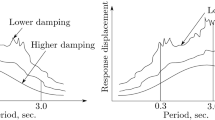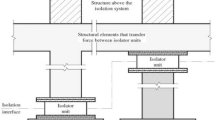Abstract
Using controlled liquefaction, a seismic isolation technique is introduced by which a large area with dozens of structures can be seismically isolated. The proposed Large Scale Seismic Isolation (LSSI) is in many ways similar to conventional base isolations. The required bearing is provided by a fully undrained pre-saturated liquefiable layer which has substantial vertical stiffness/capacity and minimal lateral stiffness. Moreover, required energy dissipation would be provided through material damping and Biot flow-induced damping within the liquefied layer. LSSI consists of a thick nonliquefiable crust layer and an underlying engineered pre-saturated liquefiable layer bounded by two impermeable thin clay layers. The liquefiable layer should be designed to trigger liquefaction as soon as possible within the early seconds of a design level seismic event. Adopting the energy-based GMP liquefaction theory, optimum gradation of the liquefiable layer is also investigated. It turned out that LSSI would effectively reduce acceleration response spectrum within short to medium periods. Contribution of the proposed LSSI is more pronounced in the case of stronger ground motions such as near field events as well as ground motions with longer return periods.
Similar content being viewed by others
References
AASHTO (2007), AASHTO Guide Specifications for LRFD Seismic Bridge Design, American Association of Highway and Transportation Officials, Washington, DC.
Andrews DCA and Martin GR (2000), “Criteria for Liquefaction of Silty Soils,” 12th World Conference on Earthquake Engineering, Auckland.
ASCE 7 (2010), Minimum Design Loads for Buildings and Other Structures, American Society of Civil Engineers (ASCE), Reston, Virginia.
ASCE 43 (2005), Seismic Design Criteria for Structures, Systems, and Components in Nuclear Facilities, American Society of Civil Engineers, Reston, Virginia.
Athanasopoulos GA, Pelekis PC and Xenaki VC (1999), “Dynamic Properties of EPS Geofoam: an Experimental Investigation,” Geosynthetics International, 6(3): 171–94.
Bardet JP (1995), “The Damping of Saturated Poroelastic Soils during Steady-state Vibrations,” Applied Mathematics and Computation, 67: 3–31.
Beskos DE, Dasgupta B and Vardoulakis IG (1986), “Vibration Isolation Using Open or Filled Trenches, Part1: 2- homogeneous Soil,” Computational Mechanics, 1(1): 43–63.
Chiaro G, Kiyota T, De Silva LIN, Sato T and Koseki J (2009), “Extremely Large Post-liquefaction Deformations of Saturated Sand under Cyclic Torsional Shear Loading,” Earthquake Geotechnical Engineering Satellite Conference, Egypt, pp. 1–10.
Demetriades GF, Constantinou MC and Reinhorn AM (1993), “Study of Wire Rope Systems for Seismic Protection of Equipment in Buildings,” Engineering Structures, 15(5): 321–34.
Dietz MS and Wood DM (2006), “Shake Table Testing of a Soft Caisson for Geotechnical Seismic Retrofit,” The 6th International Conference on Physical Modelling in Geotechnics, 6th ICPMG’06, Hong Kong.
Erochko J, Christopoulos C, Tremblay R and Choi H (2011), “Residual Drift Response of SMRFs and BRB Frames in Steel Buildings Designed According to ASCE 7-05,” Journal of Structural Engineering, 137(5): 589–99.
FEMA 440 (2005), Improvement of Nonlinear Static Seismic Analysis Procedures, Federal Emergency Management Agency, Washington, DC.
Ghosh B and Madabhusi SPG (2003), “Effects of Localized Soil Inhomogeneity in Modifying Seismic Soil Structure Interaction Effects,” 16th ASCE Engineering Mechanics Conference (EM 2003), University of Washington, Seattle, USA.
Green RA, Mitchell JK and Polito CP (2000), “An Energy-based Excess Pore Pressure Generation Model for Cohesionless Soils,” Proceedings of the John Booker Memorial Symposium Sydney, New South Wales, Australia.
Hashash YMA (2012), DEEPSOIL V 5.1, User Manual and Tutorial, University of Illinois at Urbana- Champaign, Urbana, Illinois.
Hashash YMA, Phillips C and Groholski DR (2010), “Recent Advances in Non-linear Site Response Analysis,” Fifth International Conference on Recent Advances in Geotechnical Earthquake Engineering and Soil Dynamics and Symposium in Honor of Professor I.M. Idriss, San Diego, CA.
Huang Y and Jiang X (2010), “Field-observed Phenomena of Seismic Liquefaction and Subsidence during the 2008 Wenchuan Earthquake in China,” Natural Hazards, 54(3): 839–850.
Huang Y and Yu M (2013), “Review of Soil Liquefaction Characteristics during Major Earthquakes of the Twentyfirst Century,” Natural Hazards, 65(3): 2375–2384.
Ishihara K (1985), “Stability of Natural Deposites during Earthquakes,” 11th International Conference on Soil Mechanics and Foundation Engineering, San Francisco, pp. 321–76.
Kelly J (1996), Earthquake-resistant Design with Rubber, 2nd ed, Springer-Verlag, London.
Khan Z, El-Emam M, Cascante G and El Naggar H (2012), “Energy Dissipation in Engineered Sand of Large Damping Ratio,” Geomechanics and Geoengineering: An International Journal, DOI: 10.1080/17486025.2012.695399.
Kiku H and Yoshida N (2000), “Dynamic Deformation Property Tests at Large Strains,” 12th World Conference on Earthquake Engineering, Auckland, New Zealand.
Kostadinov MV, Yamazaki F and Sudo K (2000), “Comparative Study on the Methods for Detection of Liquefaction from Strong Motion Records,” 8th ASCE Specialty Conference on Probabilistic Mechanics and Structural Reliability, University of Notre Dame, IN.
Kramer SL (1996), Geotechnical Earthquake Engineering, Prentice-Hall, Upper Saddle River, NJ.
Leilei X (2012), “Influence of In-filled Trench as Wave Barrier on Ground Vibrations,” M.Sc. Thesis, Royal Institute of Technology, Stockholm.
Li XS, Wangand ZL and Shen CK (1992), SUMDES: a Nonlinear Procedure for Response Analysis of Horizontally-layered Sites Subjected to Multi-directional Earthquake Loading, Department of Civil Engineering, University of California at Davis, CA.
Lopez FJ (2002), “Does Liquefaction Protect Overlying Structures from Ground Shaking?,” M.Sc Thesis, European School of Advanced Studies in Reduction of Seismic Risk, ROSE School, Pavia, Italy.
Lopez-Caballero F and Modaressi Farahmand-Razavi A (2008), “Numerical Simulation of Liquefaction Effects on Seismic SSI,” Soil Dynamics and Earthquake Engineering, 28(2): 85–98.
Lu LY, Shih MH and Wu CY (2004), “Near-fault Seismic Isolation Using Sliding Bearings with Variable Curvatures,” 13th World Conference on Earthquake Engineering, Vancouver, B.C., Canada, Paper No. 3264.
Lysmer J and Kuhlemeyer AM (1969), “Finite Dynamic Model for Infinite Media,” Journal of the Engineering Mechanics Division, ASCE, 95: 859–77.
Mazzoni S, Mc Kenna F, Scott MH and Fenves GL (2007), OpenSees Command Language Manual: Version 2.4.3, PEER Center, University of California at Berkeley, CA.
Menq FY (2003), “Dynamic Properties of Sandy and Gravelly Soils,” PhD dissertation, University of Texas at Austin, Austin, Texas.
Miyajima M, Kitaura M and Yamamoto M (2000), “Detection of Soil Liquefaction Using Strong Ground Motion Records,” 12th World Conference on Earthquake Engineering, Auckland.
Naeim F (2001), The Seismic Design Handbook, 2nd ed, Springer-Verlag, New York.
Patil SJ, Reddy GR, Babu R, Jayalaxmi (2012), “Natural Seismic Base Isolation of Structures Having Raft Foundations,” International Journal of Emerging Technology and Advanced Engineering, 2(8): 23–38.
PEER (2013), Strong Ground Motion Database, http://peer.berkeley.edu/smcat.
Qiu T (2010), “Analytical Solution for Biot Flowinduced Damping in Saturated Soil during Shear Wave Excitations,” Journal of Geotechnical and Geoenvironmental Engineering, 136(11): 1501–8.
Robinson WH and Tucker AG (1981), “Test Results for Lead-rubber Bearings for WM. Clayton Building, Toe Toe Bridge and Waiotukupuna Bridge,” Bulletin of the New Zealand National Society for Earthquake Engineering, 14(1): 21–33.
Schnabel PB, Lysmer JL and Seed HB (1972), “SHAKE: a Computer Program for Earthquake Response Analysis of Horizontally Layered Sites,” EERC-72/12, Earthquake Engineering Research Center, Berkeley, CA.
Seed RB, Cetin KO, Moss RES, Kammerer AM, Wu J, Pestana JM and Riemer MF (2001), “Recent Advances in Soil Liquefaction Engineering and Seismic Site Response Evaluation,” Fourth International Conference on Recent Advances in Geotechnical Earthquake Engineering and Soil Dynamics, San Diego, CA.
Seed HB, Wong RT, Idriss IM and Tokimatsu K (1986), “Moduli and Damping Factors for Dynamic Analysis of Cohesionless Soils,” Journal of Geotechnical Engineering, 112(11): 1016–32.
Shirvastava RK and Kameswara Rao NSV (2002), “Response of Soil Media due to Impulse Loads and Isolation Using Trenches,” Soil Dynamics and Earthquake Engineering, 22: 695–702.
Soong TT and Dargush GF (1997), Passive Energy Dissipation Systems in Structural Engineering, John Wiley, Chichester, UK.
Stewart JP, Lei Kwok AO, Hashash YMA, Matasovic N, Pyke R, Wang Z and Yang Z (2008), “Benchmarking of Nonlinear Geotechnical Ground Response Analysis Procedures,” PEER Report 2008/04, University of California, Berkeley, CA.
Woods RD (1968), Screening of Surface Waves in Soils, University of Michigan, Ann Arbor, Michigan.
Yamamoto S, Kikuchi M, Ueda M and Aiken ID (2009), “A Mechanical Model for Elastomeric Seismic Isolation Bearings Including the Influence of Axial Load,” Earthquake Engineering and Structural Dynamics, 38: 157–80.
Yegian MK and Kadakal U (2004), “Foundation Isolation for Seismic Protection Using a Smooth Sysnthetic Liner,” Journal of Geotechnical and Geoenvironmental Engineering, 130(11): 1121–30.
Yoshida N and IAI S (1998), “Nonlinear Site Response and Its Evaluation and Presiction,” Proc. 2nd International Symposium on the Effect of Surface Geology on Seismic Motion, Yokosuka, Japan, pp. 71-90.
Zarnani S and Bathurst RJ (2009), “Numerical Parametric Study of Expanded Polystyrene (EPS) Geofoam Seismic Buffers,” Canadian Geotechnical Journal, 46: 318–38.
Author information
Authors and Affiliations
Corresponding author
Rights and permissions
About this article
Cite this article
Mousavi, S.A., Bastami, M. & Zahrai, S.M. Large-scale seismic isolation through regulated liquefaction: a feasibility study. Earthq. Eng. Eng. Vib. 15, 579–595 (2016). https://doi.org/10.1007/s11803-016-0350-0
Received:
Accepted:
Published:
Issue Date:
DOI: https://doi.org/10.1007/s11803-016-0350-0




